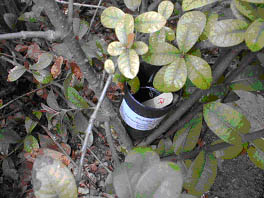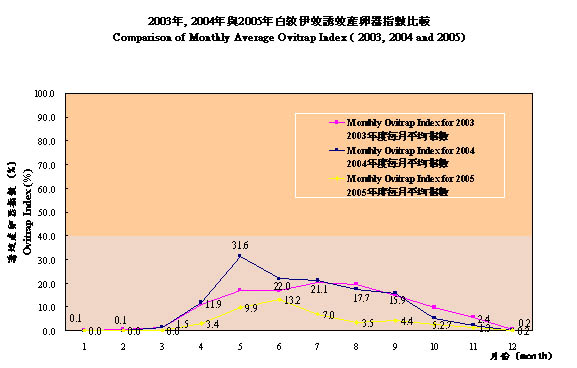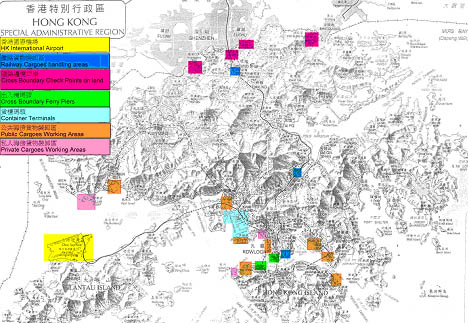| INSIDE THIS ISSUE | Ovitrap Survey in Community and Port Areas | Differences between Mosquitoes and "Non-biting Midges |
|---|
Ovitrap Survey in Community and Port Areas
Background
Dengue fever, a mosquito-borne disease, commonly occurs in tropical and subtropical region. In Hong Kong, Aedes albopictus, a vector of dengue, is commonly found. FEHD has put in place a dengue vector surveillance programme to monitor the distribution of Aedes albopictus at selected locations, evaluate the effectiveness of mosquito prevention and control work, and provide surveillance information for making timely adjustments to our mosquito control strategies and measures.
The ovitrap surveys are carried out in both the community (38 locations from all districts) and 30 port areas (divided into 7 groups namely, airport, railway cargoes handling areas, public cargoes working areas, private cargoes working areas, container terminals, cross boundary check points on land and cross boundary ferry piers).

Ovitraps used for dengue vector survey
Ovitrap Index is enumerated by the formula :
Ovitrap Index = No. of Aedes-positive ovitraps / No. of ovitraps collected from the specific area x 100%
The index is classified into 4 levels (namely Level 1 when OI<5%, Level 2 when 5<=OI<20%, Level 3 when 20%<=OI<40% and Level 4 when OI>=40%). Specific preventive and control measures will be initiated accordingly. Management of housing estates, hospitals, schools, construction sites, and other venues or properties are also advised to take specific measures to contain mosquito problems in their own properties.
Ovitrap Survey in Community
Two different indices, namely Area Ovitrap Index (AOI), and Monthly Ovitrap Index (MOI), would be enumerated. AOI indicates the extensiveness of the distribution of Aedes albopictus in that particular area surveyed while the MOI is the average of all AOIs within the same month, which reflects the distribution and activity of Aedes albopictus in the whole territory. The location of ovitraps would be reviewed annually. In 2006, adjustments in ovitrap locations have been made in Sheung Wan (which has been renamed as Central, Sheung Wan and Sai Ying Pun), Kennedy Town (which has been renamed as Sai Wan), Yau Ma Tei (renamed as Mongkok) and Tsim Sha Tsui.

Comparison of monthly average ovitrap indices of 2003, 2004 and 2005
Ovitrap survey in port areas
Port Ovitrap Index (POI), and Port Monthly Ovitrap Index (PMOI), would be enumerated. POI indicates the extensiveness of the distribution of Aedes albopictus in a particular group of port areas while the PMOI is the average of all POIs within the same month, which reflects the overall situation of Aedes albopictus in port areas. The list of ports under surveillance remained unchanged since its commencement in 2004, even though the survey areas might have been adjusted with respect to the development of individual port. For example, the newly open Asia World Expo on Chek Lap Kok Island has been included as part of our surveillance programme conducted in Airport in 2006.

Map showing the locations of surveyed port areas
Follow up actions
The ovitrap indices, once available, are notified to the relevant government departments through a computer information system called Geospatial Information Hub. Detailed information of positive ovitrap locations and surrounding environments could be obtained from the system to facilitate the mosquito control work. Besides, the indices are also announced each month through FEHD's website (http://www.fehd.gov.hk) and press release to arouse public awareness of the situation of mosquito breeding in respective districts and to enlist community participation in mosquito control work.
Differences between Mosquitoes and "Non-biting Midges"
Adult "non-biting midges" is always erroneously regarded as mosquitoes by the public due to their similar body size and morphology. Although both "non-biting midges" and mosquitoes belong to the order Diptera, they are in fact two very different kinds of creatures. In this issue, their biology and medical importance are compared to delineate their similarities and differences.
| Mosquitoes | Non-biting Midges | |||||||||||||
|---|---|---|---|---|---|---|---|---|---|---|---|---|---|---|
| Classification |
Class Order Family |
 |
Class Order Family |
 |
||||||||||
| Life Cycle |
|
|
||||||||||||
| Breeding Habitat | Water | Water | ||||||||||||
| Egg | Brown or black in colour | Transparent | ||||||||||||
| Larva | Most species have translucent body with brownish pigment; stay at water surface |  |
Most species are red in colour; live at bottom, on submerged plants or objects |  |
||||||||||
| Oxygen Intake of Larva and Pupa | From atmospheric air | From dissolved oxygen in water | ||||||||||||
| Adult Female | With piercing and sucking mouthpart; most are blood-feeding | No piercing and sucking mouthpart; non-biting and do not feed | ||||||||||||
| Life Span of Adult | Female can live for 1 month | Usually less than 1 day | ||||||||||||
| Flight Ability | Usually strong flier | Weak flier | ||||||||||||
| Medical Importance | Can transmit mosquito-borne diseases, e.g. malaria, dengue fever, Japanese encephalitis; also cause irritation through bites | Not regarded as an important disease vector, though it can induce allergic diseases | ||||||||||||
| Control of Larvae and Pupae by Oil | Effective | Ineffective | ||||||||||||
More informaiton on pest prevention and control can be obtained from other pages of our website


